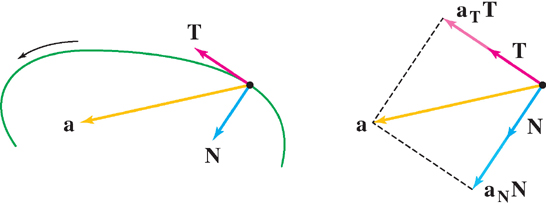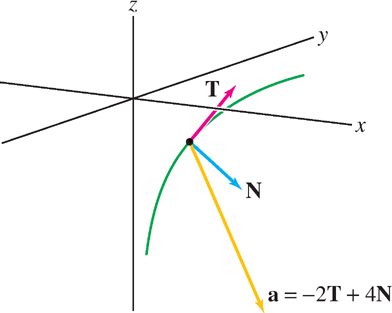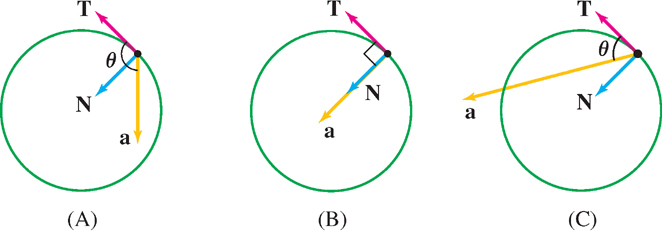Understanding the Acceleration Vector
We have noted that v(t) can change in two ways: in magnitude and in direction. To understand how the acceleration vector a(t) “encodes” both types of change, we decompose a(t) into a sum of tangential and normal components.
Recall the definition of unit tangent and unit normal vectors:

Thus, v(t) = υ(t)T(t), where υ(t) = ∥v(t)∥, so by the Product Rule,

Furthermore, T′(t) = υ(t)κ(t)N(t) by Eq. (7) of Section 13.4, where κ(t) is the curvature. Thus we can write

When you make a left turn in an automobile at constant speed, your tangential acceleration is zero (because υ′(t) = 0) and you will not be pushed back against your seat. But the car seat (via friction) pushes you to the left toward the car door, causing you to accelerate in the normal direction. Due to inertia, you feel as if you are being pushed to the right toward the passenger’s seat. This force is proportional to κυ2, so a sharp turn (large κ) or high speed (large v) produces a strong normal force.
The coefficient aT(t) is called the tangential component and aN(t) the normal component of acceleration (Figure 5).

The normal component aN is often called the centripetal acceleration, especially in the case of circular motion where it is directed toward the center of the circle.
CONCEPTUAL INSIGHT
The tangential component aT = υ′(t) is the rate at which speed υ(t) changes, whereas the normal component aN = κ(t)υ(t)2 describes the change in v due to a change in direction. These interpretations become clear once we consider the following extreme cases:
A particle travels in a straight line. Then direction does not change [κ(t) = 0] and a(t) = υ′(t)T is parallel to the direction of motion.
A particle travels with constant speed along a curved path. Then υ′(t) = 0 and the acceleration vector a(t) = κ(t)υ(t)2N is normal to the direction of motion.
General motion combines both tangential and normal acceleration.
760
EXAMPLE 5
The Giant Ferris Wheel in Vienna has radius R = 30 m (Figure 6). Assume that at time t = t0, the wheel rotates counterclockwise with a speed of 40 m/min and is slowing at a rate of 15 m/min2. Find the acceleration vector a for a person seated in a car at the lowest point of the wheel.

Solution At the bottom of the wheel, T = 〈1, 0〉 and N = 〈0, 1〉. We are told that aT = υ′ = −15 at time t0. The curvature of the wheel is κ = 1/R = 1/30, so the normal component is aN = κv2 = υ2/R = (40)2/30 ≈ 53.3. Therefore (Figure 7),
a ≈ −15T + 53.3N = 〈−15, 53.3〉 m/min2

The following theorem provides useful formulas for the tangential and normal components.
THEOREM 1: Tangential and Normal Components of Acceleration
In the decomposition a = aTT + aNN, we have

and

Proof
We have T · T = 1 and N · T = 0. Thus

and since  , we have
, we have

and

Finally, the vectors aTT and aNN are the sides of a right triangle with hypotenuse a as in Figure 5, so by the Pythagorean Theorem,

Keep in mind that aN ≥ 0 but aT is positive or negative, depending on whether the object is speeding up or slowing down.
EXAMPLE 6
Decompose the acceleration vector a of r(t) = 〈t2, 2t, ln t〉 into tangential and normal components at  (Figure 8).
(Figure 8).

 on the curve r(t) = 〈t2, 2t, ln t〉.
on the curve r(t) = 〈t2, 2t, ln t〉.Solution First, we compute the tangential components T and aT. We have

761
At  ,
,

Thus

and by Eq. (3),

Next, we use Eq. (4):

Summary of steps in Example 6:

This vector has length

and thus

Finally, we obtain the decomposition
a = 〈2, 0,-4〉 = aTT + aNN = −2T + 4N
EXAMPLE 7: Nonuniform Circular Motion
Figure 9 shows the acceleration vectors of three particles moving counterclockwise around a circle. In each case, state whether the particle’s speed υ is increasing, decreasing, or momentarily constant.

REMINDER
By Eq. (3), v′ = aT = a · T
v · w = ∥v∥ ∥w∥ cos θ
where θ is the angle between v and w.
Solution The rate of change of speed depends on the angle θ between a and T:
v′ = aT = a · T = ∥a∥ ∥T∥ cos θ = ∥a∥ cos θ
In (A), θ is obtuse so cos θ < 0 and υ′ < 0. The particle’s speed is decreasing.
In (B),
 so cos θ = 0 and υ′ = 0. The particle’s speed is momentarily constant.
so cos θ = 0 and υ′ = 0. The particle’s speed is momentarily constant.In (C), θ is acute so cos θ > 0 and υ′ > 0. The particle’s speed is increasing.
762
EXAMPLE 8
Find the curvature  for the path r(t) = 〈t2, 2t, ln t〉 in Example 6.
for the path r(t) = 〈t2, 2t, ln t〉 in Example 6.
Solution By Eq. (2), the normal component is
aN = κv2
In Example 6 we showed that aN = 4 and v = 〈1, 2, 2〉 at  . Therefore, v2 = v · v = 9 and the curvature is
. Therefore, v2 = v · v = 9 and the curvature is  .
.